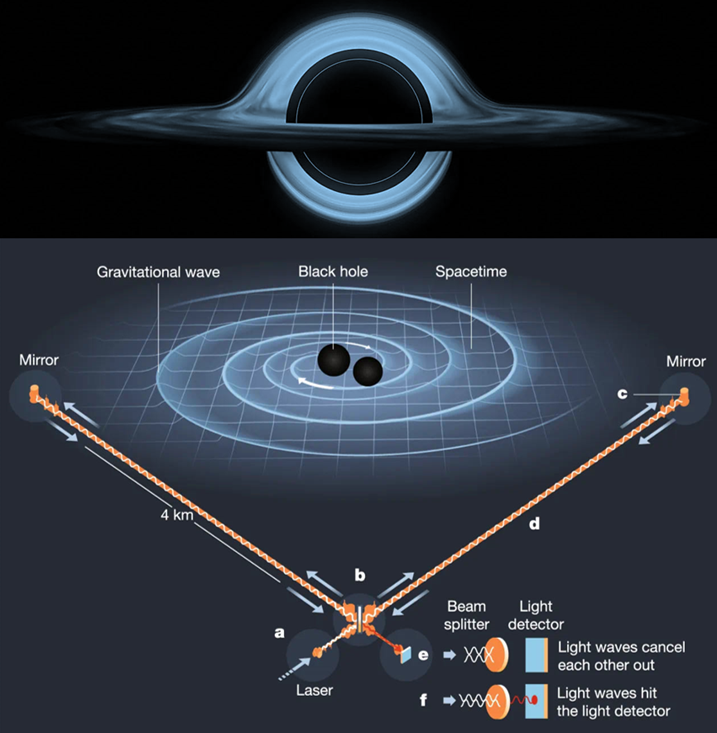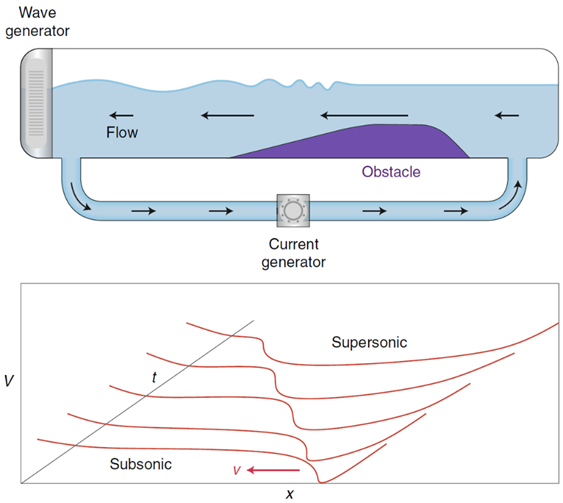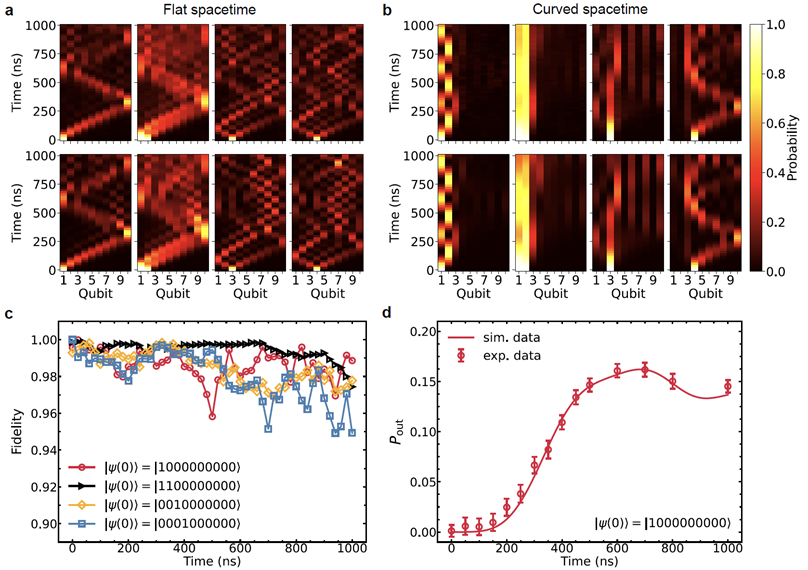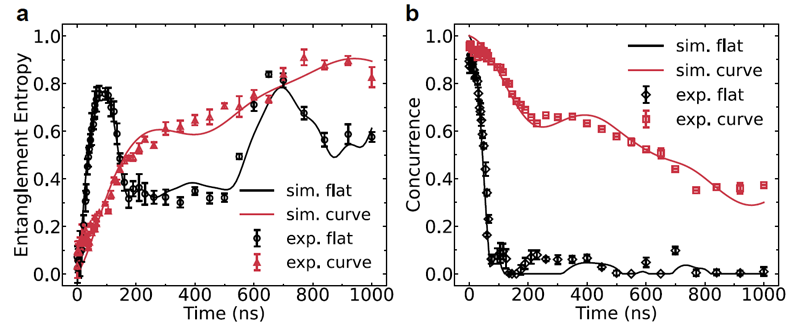Quantum Cloud Group of BAQIS Realized the Quantum Simulation of Hawking Radiation and Curved Spacetime with a Superconducting On-Chip Black Hole
2023/06/16
Recently, the Quantum Cloud group of BAQIS and the Institute of Physics, Chinese Academy of Sciences, realized an analogue lattice black hole model for the first time on a superconducting quantum chip with tunable couplers, and observed analogue Hawking radiation and the related entanglement dynamics. On June 5, 2023, the research results were published in Nature Communications under the title “Quantum simulation of Hawking radiation and curved spacetime with a superconducting on-chip black hole”.
Black holes are a special kind of celestial bodies predicted by Einstein's general theory of relativity. It creates a gravitational field so strong that not even light can escape from its surface. In recent years, people have confirmed the widespread existence of black holes in the universe through indirect means, such as the radiation emitted by objects before being sucked into the black hole and the orbits of surrounding stars and interstellar clouds. Black hole mergers produce gravitational waves, and large facilities such as LIGO and Virgo have observed many black hole mergers. In addition, Hawking pointed out that after taking into account quantum effects, black holes also produce quantum radiation due to the quantum fluctuations of the vacuum. The corresponding radiation temperature is called the “Hawking temperature”. For a solar-mass black hole, its Hawking temperature is only about 10-8 K, which is much lower than the temperature of the cosmic microwave background radiation (about 3K). Therefore, from the point of view of current technology, observing the weak quantum effects generated by real gravitational systems still seems to be technologically out of reach.

Fig. 1. Astronomical black holes and gravitational wave detection concept map.
Given this, people have tried to create an equivalent “black hole” in a laboratory system and explore the “analog gravity” effect it brings. The “analog gravity” experiment was first proposed by William G. Unruh in 1981, who demonstrated that the massless scalar field equation in a gravitational field is equivalent to the equation of sound waves in a moving fluid and that the behavior of a field near the event horizon of a black hole can be described by sound waves in a transonic fluid. Just as light cannot escape from a black hole, phonons can only propagate within the subsonic flow region, and the boundary between the subsonic and supersonic regions represents the event horizon of the “acoustic black hole” or the “acoustic horizon”. If we consider the quantization of the sound field, this acoustic horizon will have a non-zero temperature and spontaneously radiate phonons outward, an effect exactly analogous to the “Hawking radiation” of a black hole. The proposed “analog gravity” system reduces the technical requirements for the experimental study of Hawking radiation, allowing people to construct an equivalent black hole spacetime and simulate interesting and profound phenomena such as Hawking radiation in a relatively economical and smaller laboratory.

Fig. 2. Analogue horizons in shallow water waves and Bose-Einstein condensate systems.
This experimental work was inspired by the previous theoretical work of collaborators Rong-Gen Cai (Institute of Theoretical Physics, CAS) and Run-Qiu Yang (Tianjin University). This theoretical work shows that 1+1 dimensional scalar and Dirac fields can be quantized under Eddton-Finkelstein coordinates, considering massless limit and discretization of spatial coordinates, and are equivalent to the XY lattice model with site-dependent couplings; The metric information of the curved space-time background is encoded into the distribution function of the coupling strength. However, how to implement such an XY lattice model with a specific distribution of coupling strength in an experiment is a very challenging problem.
In order to overcome this challenge, the group used a one-dimensional array superconducting quantum chip with 10 qubits and 9 couplers. By precisely controlling the couplers, the effective coupling strength between the qubits was distributed from negative to positive to achieve a 1+1 dimensional curved space-time background. The propagation behavior of quasi-particles in the curved space-time background was observed. The results show that the quasi-particle inside the black hole always has a certain probability of radiating out through the event horizon, and their radiation probability meets the blackbody spectrum of Hawking radiation. The group used quantum state tomography to reconstruct the density matrix of all the qubits outside the black hole, calculated the corresponding radiation probability, and experimentally verified the analogue Hawking radiation. In addition, the group prepared a Bell entangled state inside the black hole and compared the entanglement dynamics in the flat and curved spacetime.

Fig. 3. On-chip analogue black hole, the site-dependent effective coupling strengths, and partial experimental pulse sequences.
In this experiment, with the help of superconducting quantum devices with tunable couplers, both flat and curved spacetime are realized, and the radiation spectrum is obtained by multi-qubit state tomography of the superconducting quantum system. The entanglement evolution is clearly demonstrated, showing the high controllability of the superconducting quantum system and providing ideas for simulating many phenomena.
This research is completed through the collaboration of the following authors: Yun-Hao Shi, a Ph.D. student from the Institute of Physics, Chinese Academy of Sciences; Heng Fan, Kai Xu, Dongning Zheng, Zhongcheng Xiang, Kaixuan Huang, Ye Tian, Xiaohui Song from the Quantum Cloud group of Beijing Academy of Quantum Information Sciences and the Institute of Physics, Chinese Academy of Sciences; Rong-Gen Cai, a research fellow from Institute of Theoretical Physics, Chinese Academy of Sciences; Run-Qiu Yang, an associate professor from Tianjin University; Zi-Yong Ge, a postdoctoral researcher from RIKEN; and Hao Li and Yong-Yi Wang, Ph.D. students from the Institute of Physics, Chinese Academy of Sciences. This work is supported by the National Natural Science Foundation of China, Beijing Natural Science Foundation, and the Strategic Priority Research Program of Chinese Academy of Sciences.

Fig. 4. Quantum walks in flat and curved spacetime.

Fig. 5. Observation of analogue Hawking radiation.

Fig. 6. Dynamics of entanglement in the analogue black hole.
URL: https://www.nature.com/articles/s41467-023-39064-6
 中文
中文 Email
Email QCloud
QCloud Log in
Log in
